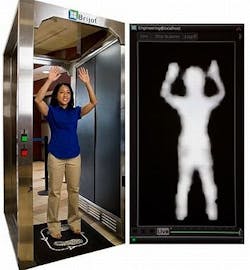Navy and Boeing to apply passive millimeter wave imaging technology to persistent surveillance and perimeter security
CHINA LAKE NAVAL AIR WEAPONS STATION, Calif., 5 July 2012. U.S. Navy researchers are asking military sensors experts at the Boeing Co. Defense, Space & Security segment in Huntington Beach, Calif., to develop the Passive Millimeter Wave Imaging System (PMMWIS) to monitor the movements of people and vehicles at military facilities.
The Naval Air Warfare Center Weapons Division (NAWCWD) at China Lake Naval Air Weapons Station in Ridgecrest, Calif., are awarding a $3.5 million contract to Boeing to develop a PMMWIS sensor that produces images, helps classify objects as human or non-human, and recognizes moving and stationary vehicles in persistent-surveillance and perimeter-security applications (story continues below).
Passive millimeter wave imaging technology, which is used on some full-body scanning systems that screen passengers at airport security checkpoints, reflects extremely high-frequency radio waves off objects to make an image. Passive millimeter wave sensors use raw energy emitted from people and objects, and does not transmit millimeter waves.
Passive millimeter wave imaging technology also is being applied to enhanced vision systems for aircraft cockpits to help enhance aircraft safety in extremely poor visibility.
Boeing engineers will design each PMMWIS sensor to have a wide field of regard to enable a small number of these millimeter wave sensors to provide complete perimeter coverage at a naval facility. This system must operate in daylight and at night, as well as and under reduced-visibility conditions such as fog, smoke, dust, and rain, Navy officials say.
The Naval Air Warfare Center is working together on the PMMWIS program with the Office of Naval Research (ONR) in Arlington, Va. Navy experts say they envision the PMMWIS program as part of a multi-sensor suite using sensor fusion and automatic image evaluation to determine the best imagery for any situation.
Boeing sensors experts will design the Passive Millimeter Wave Imaging System in two phases. First, Boeing will develop models and simulations. Second, they will fabricate the PMMWIS sensor and demonstrate its imaging capability under reduced visibility conditions.
For more information contact Boeing Defense, Space & Security online at www.boeing.com/bds, the Naval Air Warfare Center Weapons Division at www.navair.navy.mil/nawcwd, or the Office of Naval Research at www.onr.navy.mil.
Follow Military & Aerospace Electronics and Avionics Intelligence news updates on Twitter

